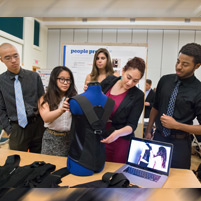Engineered Designs

Students who enrolled in the two-semester Biomedical Engineering Design course used interdisciplinary teamwork to create solutions to medical problems.
One project, designed to help patients with neuromuscular diseases, is moving beyond the classroom and is being explored for commercial potential.
Biomedical Engineering Design brings together students from diverse backgrounds to develop solutions for "real-world" medical problems from concept all the way to prototype.
"Engineering, design and humanities students have pedagogies and skill sets that are significantly different from each other," said Conrad Zapanta, associate head of CMU's Department of Biomedical Engineering. "This results in three groups of undergraduates who both think and work very differently. Teams composed of students across colleges produce unique solutions that are only possible through these interactions."
During the 2013–2014 academic year, 15 teams developed projects, ranging from developing sterilizers for low-resource areas to a brace for rehabilitating Achilles tendon injuries. Past projects from the course have been developed further and are being used clinically.
"All of the projects have the potential to make significant impacts in the health of the end-users," Zapanta said.
Patients with neuromuscular diseases such as Parkinson's, for example, could potentially benefit from the PeopleProp brace developed by Chava Angell (E'14), Felix Chiu (E'14), Keith Joseph (A'15), Liana Kong (A'15) and Victoria Patino (E'14).
"We designed the brace to alleviate some of the symptoms of postural instability associated with the disease," Angell said.
"Parkinson's patients tend to slump over, and that can cause difficulties in breathing," Angell added. "As you can see, our brace pulls back the shoulders, providing a lot more support. It's very lightweight and comfortable."
Many braces on the market are rigid and limit the range of motion required for day-to-day activities. This team's solution is made of spandex, Velcro and a cotton blend.
"Also, our brace is unobtrusive. A patient can wear this under clothing, taking away the stigma associated with wearing this kind of corrective piece in public," Angell said.
The brace is now being used as a Project Olympus PROBE (PRoblem-Oriented Business Exploration) to investigate if it has commercial potential. The program is part of the Center for Innovation and Entrepreneurship under the leadership of Dave Mawhinney and Lenore Blum.
A key goal of any PROBE is to augment and accelerate the process of moving basic research and great ideas into development and business stages with licensing, spin-offs, startups and corporate collaboration and partnering.
Photo: Felix Chiu (E'14), Liana Kong (A'15), Victoria Patino (E'14), Chava Angell (E'14), and Keith Joseph (A'15), developed the PeopleProp brace to support patients with neuromuscular diseases.
Related Links: Department of Biomedical Engineering | Center for Innovation and Entrepreneurship | Project Olympus
